INTRODUCTION
Buddhist monks, or Bhikkhus, hold a revered status in Thai society, serving as spiritual leaders and cultural figures dedicated to a monastic way of life [1]. In Thailand, where Therav?da Buddhism is deeply ingrained in the culture, there were 256,219 Bhikkhus as reported by the National Office of Buddhism in 2023 [2]. The daily lives of Bhikkhus are governed by the 227 precepts of the Sila Patimokkha, which regulate their behavior, interactions, and routines. These precepts significantly influence their health, medication use, and healthcare-seeking behaviors. For example, Bhikkhus are prohibited from handling money and rely on lay supporters to procure medications and other necessities. They are also restricted to consuming food only between dawn and noon, complicating medication administration schedules, especially for drugs that require food for optimal absorption or multiple daily doses. Additionally, their reliance on food offerings from laypeople results in inconsistent nutritional intake, potentially affecting the efficacy and safety of certain medications [3,4]. These religious practices, combined with the Bhikkhus’ perception of illness and healthcare, present unique challenges for effective pharmacotherapy. Healthcare practitioners must navigate these cultural nuances while ensuring that Bhikkhus receives appropriate and effective treatments [1].
There is a growing population of elderly Bhikkhus, partly due to demographic shifts and the tradition of late-life ordination among older individuals seeking spiritual devotion. According to Thailand’s National Statistical Office, the elderly population has surged in recent years, with similar trends observed among monastic communities [5]. Elderly Bhikkhus commonly experience age-related physiological changes, summarized as reduced physiological reserves, atypical disease presentations, multiple comorbidities, polypharmacy, and social vulnerability. Chronic metabolic conditions, including hypertension, diabetes, dyslipidemia, and overweight or obesity, have been reported with high prevalence rates among elderly Bhikkhus, ranging from 22.9% to 63.8%, 10.0% to 40.0%, 35.9%, and 45.1%, respectively [1]. Elderly Bhikkhus reside in monasteries, presenting a unique set of healthcare challenges due to their spiritual commitments, religious practices, and age-related health issues. Addressing these challenges requires healthcare providers to recognize and respect the cultural and spiritual context of this population [6].
Drug-related problems (DRPs) are a significant concern in the elderly, who are extremely affected by age-related changes in pharmacokinetics and pharmacodynamics. Polypharmacy, drug interactions, adverse drug reactions, and non-adherence are particularly prevalent among older adults, often resulting in hospitalizations, reduced quality of life, and increased healthcare costs [7]. Tools such as the Beers criteria [8], developed in the United States, and the Screening Tool of Older Persons’ Prescriptions (STOPP) criteria [9], developed in Europe, are widely used to identify potentially inappropriate medication (PIM) and improve medication safety in elderly populations.
Although DRPs in elderly Bhikkhus share certain similarities with those observed in other elderly populations, remarkable discrepancies arise due to the unique lifestyle and religious practices of Bhikkhus [10]. Existing tools for identifying PIM, such as the Beers and STOPP criteria, do not account for these distinctive factors. To address this gap, the PIM-BHIKKHU criteria were developed to evaluate medication appropriateness, specifically in elderly Bhikkhus. By integrating cultural and spiritual considerations, the PIM-BHIKKHU criteria aim to optimize pharmacotherapy and improve the quality of care for this under-researched population. The 2024 PIM-BHIKKHU criteria were piloted at the Priest Hospital, a specialized facility in Bangkok, Thailand, providing comprehensive outpatient care exclusively for Buddhist monks since January 2024. However, the comprehensiveness and effectiveness of this newly developed tool have not yet been evaluated.
This study aimed to 1) determine the prevalence of PIMs among outpatient elderly Thai Bhikkhus using the 2024 PIM-BHIKKHU criteria, the 2023 Beers criteria, and STOPP criteria version 3; and 2) compare the prevalence and evaluate the effectiveness of PIMs identified by the three criteria.
METHODS
Study design
This retrospective cross-sectional study was conducted by reviewing prescription records of outpatient elderly Bhikkhus at the Priest Hospital, Bangkok, Thailand. The study proposal was approved by the institutional review board of the study site (approval ID 17/2566), which waived the requirement for informed consent due to the retrospective nature of the study. Patient confidentiality was strictly maintained, and all data were anonymized before analysis. The study adhered to the ethical principles outlined in the Declaration of Helsinki. The study proposal was approved by the institutional review board of the study site (approval ID 17/2566).
STUDY PARTICIPANTS
Inclusion and exclusion criteria
The study population included outpatient elderly Bhikkhus receiving care at the Priest Hospital. The inclusion criteria were as follows: 1) elderly Bhikkhus aged 65 years or older, 2) follow-up visits at the outpatient departments of the hospital between January 2024 and August 2024, and 3) concurrent use of at least five medications. Patients were excluded if they had incomplete medication data, received care from multiple healthcare facilities, had terminal illnesses, or were participating in investigational drug studies or clinical trials.
Sample size determination and sampling method
The sample size was determined using prevalence data from our preliminary study, which found that 66%, 41%, and 83% of elderly Bhikkhus received at least one PIM according to the 2023 Beers criteria, STOPP criteria version 3, and the 2024 PIM-BHIKKHU criteria, respectively. Based on a formula for prevalence studies with a significance level (alpha) of 0.05 and a margin of error of 5% [11], the minimum required sample size was calculated to be 223 patients. Systematic random sampling was employed to select participants from a list of eligible patients. The sampling interval was calculated by dividing the total number of eligible patients by the required sample size. If a selected patient met any exclusion criteria, the next eligible patient in the sequence was included to maintain the systematic sampling approach.
Data collection
Data collection was conducted in September 2024 by reviewing patients’ medical and prescribing records. The collected data included age, order (Nikaya), comorbidities, Charlson comorbidity index score, and prescribed medications. PIM was initially assessed by the first author (PP) and subsequently rechecked by another author (KY) using three criteria: the 2023 Beers criteria, the STOPP criteria version 3, and the 2024 PIM-BHIKKHU criteria. Discrepancies in PIM identification were resolved by discussion and consulting with other experts at the institution.
The PIM-BHIKKHU criteria
The development of the 2024 PIM-BHIKKHU criteria was based on a comprehensive literature review of existing PIM criteria, followed by a Delphi consensus process. The initial draft was formulated through a review of key references, including the 2023 Beers criteria [8] and the STOPP criteria version 3 [9]. This draft then underwent two rounds of consensus-building using the Delphi method, involving a panel of 7 physicians and 13 pharmacists with expertise in geriatric care, rational medication prescribing, and the specific healthcare needs of Bhikkhus. Medications were included in the final 2024 PIM-BHIKKHU criteria if they met the following consensus thresholds: a median agreement score of at least 3.5 out of 5, an interquartile range (IQR) not exceeding 1.5, and a difference of no more than 15% between the median scores of the first and second Delphi rounds. The final version of the 2024 PIM-BHIKKHU criteria consists of two sections: one applicable to the general elderly population (78 items) and another specifically tailored for elderly Bhikkhus (12 items).
Data analysis
The prevalence of PIM prescribing, as assessed by each criterion, was calculated as the number of Bhikkhus receiving at least one PIM (numerator) divided by the total number of participants. Descriptive statistics, including mean, standard deviation (SD), median, IQR, and percentage, were used in data analysis and presentation. Differences among the three criteria were evaluated using the Cochran Q test for categorical data or the Kruskal–Wallis test for continuous data. Post hoc pairwise comparisons were conducted using McNemar’s test with Bonferroni correction. Data analysis was performed using SPSS software, version 26.0 (SPSS Inc., USA). Statistical significance was set at p < 0.05.
RESULTS
Participant characteristics
A total of 225 patients’ medical and prescription records were reviewed. The majority of participants belonged to the Mahanikaya order and resided in Bangkok or metropolitan provinces. The mean age of the participants was 72.81 years (SD 6.21), with 34.22% aged 75 years or older. The mean number of comorbidities was 3.65 (SD 1.47). The three most prevalent comorbidities were dyslipidemia (64.00%), hypertension (57.78%), and musculoskeletal disorders (54.67%). The median Charlson comorbidity index score was 1 point (IQR: 0, 2). Participants were prescribed an average of 9.40 concurrent medications (SD 4.46). Additional details of participant characteristics are presented in Table 1.
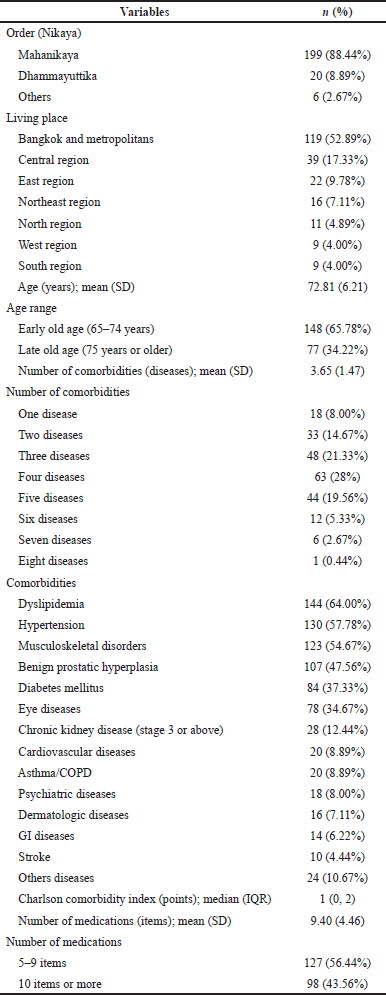 | Table 1. Participant characteristics (N = 225 Bhikkhus). [Click here to view] |
Prevalences and characteristics of PIM prescribing
The prevalence of PIM prescribing among elderly Bhikkhus, as assessed by the 2023 Beers criteria, STOPP criteria version 3, and the 2024 PIM-BHIKKHU criteria, was 60.00%, 45.33%, and 87.56%, respectively. The prevalences identified by the 2024 PIM-BHIKKHU criteria were significantly higher compared to both the 2023 Beers criteria (by 27.56%; 95%CI: 20.70%, 34.41%) and the STOPP criteria version 3 (by 42.22%; 95%CI: 33.73%, 50.71%), with statistically significant differences (Table 2). Additionally, PIM prescribing was more prevalent among elderly Bhikkhus aged 75 years or older across the three criteria. The 2024 PIM-BHIKKHU identified PIM at a significantly higher prevalence than other criteria in both age groups, as shown in Table 2 and Figure 1.
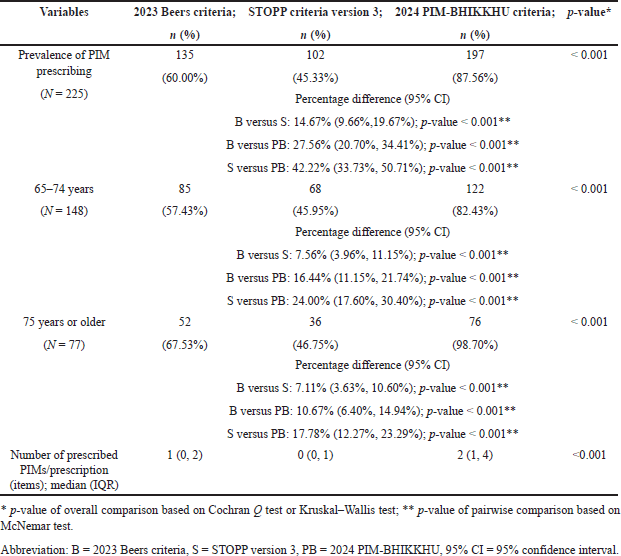 | Table 2. Prevalences of PIM prescribing among elderly Bhikkhus. [Click here to view] |
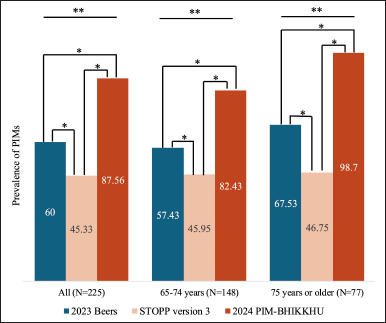 | Figure 1. Prevalence of PIMs according to three criteria. [Click here to view] |
The highest median number of PIMs per prescription was identified by the 2024 PIM-BHIKKHU, with a median of 2 items (IQR: 1, 4), which was significantly higher than the number identified by the 2023 Beers criteria and STOPP criteria version 3. This trend corresponded with the higher prevalence rates identified by the 2024 PIM-BHIKKHU criteria (Table 2 and Fig. 2).
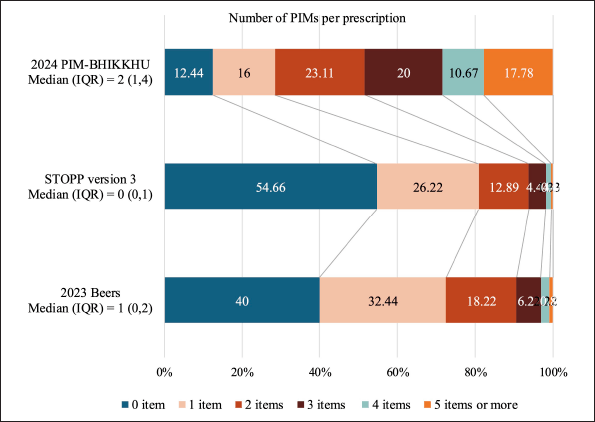 | Figure 2. Number of PIMs per prescription according to three criteria. [Click here to view] |
The most commonly prescribed PIM class was drugs acting on the cardiovascular system, followed by drugs acting on the central nervous system and musculoskeletal & pain medications. Together, these three classes accounted for more than half of all prescribed PIMs. Notably, both the 2024 PIM-BHIKKHU and 2023 Beers criteria identified a greater number of PIMs in most medication classes when compared to the STOPP criteria version 3 (Table 3) were significantly more effective than STOPP criteria version 3 in detecting PIMs across most medication classes (Table 3).
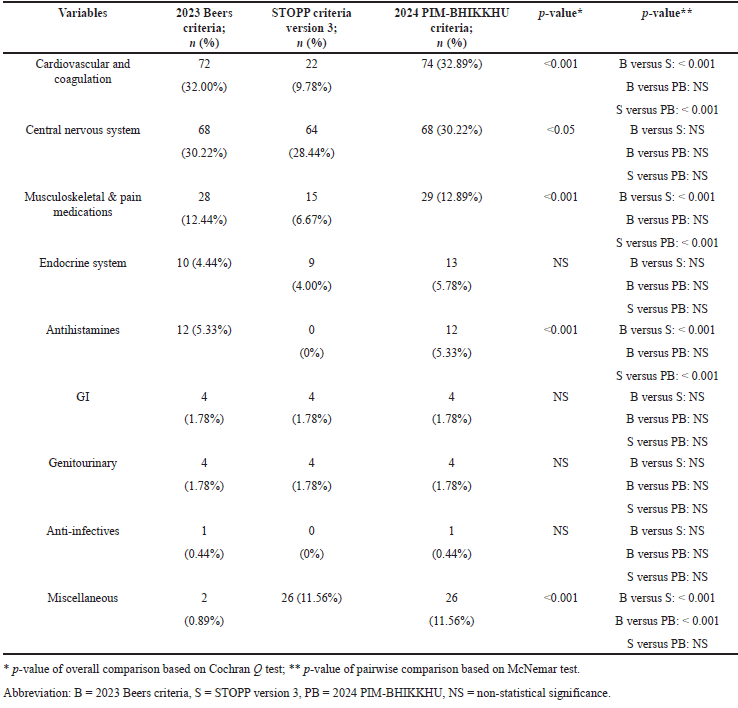 | Table 3. Prescribed PIM classes among elderly Bhikkhus (N = 225). [Click here to view] |
Identification of Bhikkhu-specific PIMs
Table 4 shows 12 additional criteria specifically developed according to the precepts and norms of Thai Bhikkhus. The most commonly identified Bhikkhu-specific PIMs were medications with complex administration methods, observed in 48% of participants. These included inhaled medications for asthma or COPD, nasal sprays, self-injectable medications, wound care products, and ophthalmic preparations. The second and third most commonly identified Bhikkhu-specific PIMs were medications to be taken immediately after meals to prevent adverse gastrointestinal (GI) effects (e.g., aspirin, metformin, tetracyclines, and potassium chloride) and medications that can cause hypoglycemia (in addition to those specified in the Beers criteria) which were found in 36.89% and 12.44%, respectively. The side effects of these medications may be more pronounced if used in the evening, as Bhikkhus are prohibited from consuming solid foods after noon. These religious precepts also affected medications that must be chewed before swallowing, medications that interact with dairy products, and medications to be taken after meals to enhance absorption. However, these types of PIMs were infrequently found in this study.
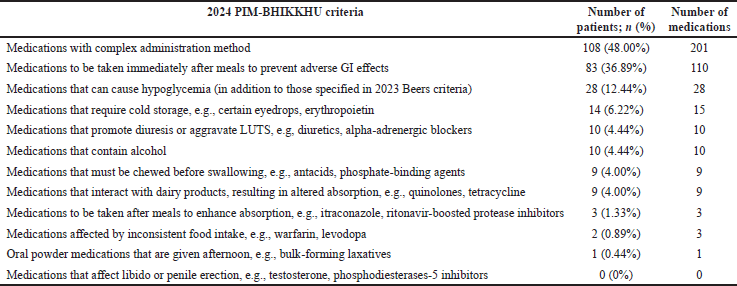 | Table 4. Identification of Bhikkhu-specific PIMs (N = 225). [Click here to view] |
DISCUSSION
This study highlights the high prevalence of PIM use among elderly Bhikkhus in Thailand and compares evaluates the effectiveness of the newly developed 2024 PIM-BHIKKHU criteria in comparison with two widely used tools, the 2023 Beers criteria and STOPP criteria version 3. The findings underscore significant medication-related challenges specific to this unique population, influenced by their religious practices and cultural norms. The PIM-BHIKKHU criteria identified a statistically significant and clinically meaningful higher proportion of PIMs compared to the Beers and STOPP criteria, with percentage differences ranging from 27.56% to 42.22% in the total study population, 16.44% to 24.00% among Bhikkhus aged 65–74 years, and 10.67% to 17.78% among Bhikkhus aged 75 years or older. These results demonstrate the enhanced sensitivity of the PIM-BHIKKHU tool in addressing the distinctive lifestyle and healthcare behaviors of Bhikkhus. By incorporating factors such as medication administration methods, fasting schedules, and reliance on laypeople for healthcare, the PIM-BHIKKHU criteria fill critical gaps left by existing PIM identification tools [8,9] offering a more culturally appropriate effective framework for rationale medication prescribing for Bhikkhus.
Bhikkhus’ traditional norms, in addition to the Patimokkha, introduce unique healthcare needs and risks. For instance, head and eyebrow shaving can cause scalp irritation or infections, necessitating topical treatments that comply with religious restrictions on cosmetics and scented products. Additionally, the daily barefoot alms round, which often involves walking long distances in forest, rice field, on concrete, or dirty roads, increases the risk of foot injuries or helminth infections, particularly in Bhikkhus with diabetes or peripheral vascular disease. These conditions require careful medication selection to address wound care and infection prevention effectively [12,13].
Religious practices, such as repetitive bowing during prayers and prolonged sitting in cross-legged positions, either in half-lotus or full-lotus posture, for meditation, can exacerbate musculoskeletal pain and osteoarthritis [13,14]. This highlights the need for safe pain management strategies that avoid PIM, such as NSAIDs, particularly in individuals with increased risks to the GI, renal, or cardiovascular systems. Furthermore, burning incense, a practice in many religious rituals releases noxious particulate matter and heavy metals [15], irritating the eyes and nose or exacerbating airway diseases, posing additional risks for Bhikkhus with pre-existing respiratory conditions [16].
Medications with complex administration methods were the most commonly identified PIMs in this study. While non-adherence to such medications is a recognized issue among the elderly, Bhikkhu may face additional challenges due to factors such as reliance on lay caregivers, communal living arrangements, cognitive decline, sensory impairments, and variations in access to reliable information [16,17]. For example, a recent survey reported that only 30.4% of elderly Bhikkhus in a particular area of Bangkok demonstrated proficiency in electronic health literacy [5].
Dietary restrictions also play a pivotal role in complicating medication use. Bhikkhus’ consumption of solid food is restricted to the period between dawn and noon, which may lead to skipped doses of medications intended for immediate use after meals. On the other hand, taking evening medications without food may increase the risk of GI side effects. Medications requiring chewing or semi-solid forms, as well as those labeled for “before” or “with” meal by default, are also impacted by these restrictions [10].
The risk of hypoglycemia is heightened among Bhikkhus due to the evening doses of insulin or other hypoglycemic agents. Morning meals are often delayed by unplanned alms rounds or temple activities, complicating the timing and administration of medications such as insulin [18]. Consequently, the use of hypoglycemic agents requires careful consideration, extending beyond the medications highlighted in the Beers criteria. Additionally, Bhikkhus are permitted to consume allowable beverages (Pana-dravya) such as fruit juices or herbal teas, after midday. Regular consumption of these beverages is a common practice, yet it poses an increased risk of uncontrolled blood glucose levels and hypertension due to their significant sugar, sodium, and caloric content. The dosing of insulin and other hypoglycemic agents must also account for this dietary behavior to prevent glycemic variability and associated complications [3,18].
Bhikkhus receive food primarily through alms rounds or temple offerings, following monastic discipline that emphasizes gratitude and non-selectivity in accepting food offerings [3,18]. This results in inconsistent dietary patterns that affect the pharmacokinetics of medications such as warfarin, levodopa, and others medications that require specific dietary considerations for optimal efficacy or safety.
The cultural and spiritual significance of food offerings further complicates dietary patterns. Laypeople often view food offerings as acts of merit or hope to share good karma with decreased family members [3]. They favor items associated with good fortune or auspiciousness by their names or appearance. Examples include Golden Pinch (Thong Yip), Golden Drops (Thong Yod), and Golden Threads (Foy Thong). These traditional Thai desserts are made primarily from egg yolks and sugar, often symbolizing prosperity and wealth, and are commonly used in ceremonial or auspicious offerings. Dishes rich in coconut milk and flavorful seasonings, considered indulgent or special meals by laypeople or the favorite foods of their decreased relatives, are also frequently offered and consumed [19]. The regular consumption of high-calorie beverages, together with energy-dense food offerings and a predominantly less physical activity lifestyle influenced by monastic precepts of self-restraint, contributes to a high prevalence of overweight, obesity, and non-communicable diseases among Thai elderly Bhikkhus [5,18,20]. Tailored interventions that incorporate dietary counseling and physical activity recommendations, such as those proposed by Laochai et al. [20] are essential to manage these risks effectively.
Bhikkhus reside in a monastic community and practice simplicity, refraining from handling money and limiting possessions to basic needs such as simple clothing and utensils. Refrigerators and air-conditioners may be unavailable in their living quarters, making medications requiring cool storage impractical [17]. Despite the availability of healthcare schemes for Bhikkhus in Thailand, financial barriers such as transportation costs and the perception of certain medications as aesthetic or luxurious incompatible with monastic simplicity contribute to medication non-adherence These challenges highlight the importance of culturally sensitive healthcare approaches that respect monastic traditions while ensuring safe and effective pharmacotherapy.
Medications containing alcohol, those that affect lower urinary tract symptoms (LUTSs), and those that influence hormonal balance or physiological responses related to sexuality may require careful consideration within the context of monastic discipline. The PIM-BHIKKHU tool explicitly addresses these issues, demonstrating its relevance for this population. By integrating Bhikkhus’ unique lifestyle and religious practices into its framework, the tool provides a more comprehensive assessment of medication appropriateness compared to existing criteria.
This study has several limitations. First, it was conducted at a single specialized hospital among a small group of outpatient elderly Bhikkhus, who were relatively healthy based on their Charlson Comorbidity Index scores and exclusion criteria. As a result, the prevalence of certain PIM classes such as warfarin, levodopa, and phosphodiesterase-5 inhibitors, which are commonly used in elderly with thromboembolism, Parkinson’s disease, and pulmonary hypertension, respectively, may have been less than expected. Thus, an underestimation of the overall PIM prevalence is anticipated especially for more vulnerable populations who may have higher medication burden and greater susceptibility to potentially inappropriate prescribing. Second, the retrospective design relied on available prescription records, which may not have captured all factors influencing medication use. Bhikkhus may also receive medications from other hospitals, laypeople’s offerings, or through sharing with other Bhikkhus, none of which were included in this analysis. Additionally, the use of alternative, complementary, or herbal medicines was not examined in this study, potentially limiting the comprehensiveness of PIM assessment. Third, we included only elderly Bhikkhus who were concurrently using at least five medications to reflect the common characteristics of geriatric patients with multiple comorbidities and mitigate the limitation of underestimating PIM prevalence. However, this inclusion criterion may introduce selection bias or other biases, potentially limiting the generalizability of our finding to Bhikkhus with fewer medications or those in different settings. Future research should explore the application of the PIM-BHIKKHU tool in broader settings and assess its impact on clinical outcomes, such as adverse drug reactions and hospitalizations.
CONCLUSION
This study demonstrates that PIM use is highly prevalent among elderly Bhikkhus in Thailand. The 2024 PIM-BHIKKHU criteria identified significantly more PIMs than the 2023 Beers criteria and STOPP criteria version 3, highlighting its superior sensitivity and relevance to this unique population. By incorporating cultural and religious practices, the PIM-BHIKKHU criteria provide a more comprehensive framework for evaluating medication appropriateness in elderly Bhikkhus.
The findings underscore the importance of developing culturally sensitive tools to address the healthcare needs of populations with distinct lifestyles. Tailored interventions, including pharmacist-led reviews, dietary counseling, and community-based support systems, are critical for optimizing medication safety and improving healthcare outcomes. Future research should assess the clinical impact of the PIM-BHIKKHU criteria in broader settings and explore its role in preventing adverse drug reactions and hospitalizations.
LIST OF ABBREVIATIONS
DRPs, drug-related problems; GI, gastrointestinal; IQR, interquartile range; PIM, potentially inappropriate medication; SD, standard deviation; STOPP, Screening Tool of Older Persons’ Prescription.
ACKNOWLEDGMENTS
We thank Parinda Peradhamanon, the head of the Department of Pharmacy, Priest Hospital, for their support of this study.
AUTHOR CONTRIBUTIONS
All authors made substantial contributions to the conception and design, acquisition of data, or analysis and interpretation of data; took part in drafting the article or revising it critically for important intellectual content; agreed to submit to the current journal; gave final approval of the version to be published; and agree to be accountable for all aspects of the work. All the authors are eligible to be an author as per the International Committee of Medical Journal Editors (ICMJE) requirements/guidelines.
FINANCIAL SUPPORT
There is no funding to report.
CONFLICTS OF INTEREST
The authors report no financial or any other conflicts of interest in this work.
ETHICAL APPROVALS
Ethical approval details are given in the ‘Methods’ section.
DATA AVAILABILITY
All data generated and analyzed are included in this research article.
PUBLISHER’S NOTE
All claims expressed in this article are solely those of the authors and do not necessarily represent those of the publisher, the editors and the reviewers. This journal remains neutral with regard to jurisdictional claims in published institutional affiliation.
USE OF ARTIFICIAL INTELLIGENCE (AI)-ASSISTED TECHNOLOGY
The authors declares that they have not used artificial intelligence (AI)-tools for writing and editing of the manuscript, and no images were manipulated using AI.
REFERENCES
1. Chisana N, Banharak S, Panpanit L, Chanaboon S, Tipkanjanaraykha K. Study of medication use and effects of medication among hospitalized older Buddhist monks: an embedded mixed-method study. J Adv Nurs. 2023;79(9):3609–21. CrossRef
2. National Office of Buddhism. Basic statistics of Buddhism 2023. Phutthamonthon, Thailand: National Office of Buddhism; 2024 [cited 2024 December 20]. Available from: https://www.onab.go.th/th/content/category/detail/id/1278/iid/90194
3. Srimantayamas V, Fongkaew W, Suksatis B, Aree P, Kosachunhanun N. Health behaviors and health-related quality of life among Buddhist monks with metabolic syndrome. Pacific Rim Int J Nurs Res. 2020;24(2):159–71.
4. Artsanthia J, Techakuljareon P. Buddhist monk illness nursing care follows Dharma. J Royal Thai Arm Nurs. 2019;20(3):27–33.
5. Ko-amornsup W, Siriussawakul A, Aosangdeekul K, Preesachitkul R, Srinonprasert V, Somnuke P, et al. Health survey of Monks residing in urban areas: the Bangkok Noi model. Siriraj Med J. 2024;76:746–57. CrossRef
6. Jeamjitvibool T, Tankumpuan T, Lukkahatai N, Davidson PM. Noncommunicable diseases and social determinants of health in Buddhist monks: an integrative review. Res Nurs Health. 2022;45(2):249–60. CrossRef
7. Andres TM, McGrane T, McEvoy MD, Allen BFS. Geriatric pharmacology: an update. Anesthesiol Clin. 2019;37(3):475–92. CrossRef
8. By the 2023 American Geriatrics Society Beers Criteria® Update Expert Panel. American Geriatrics Society 2023 updated AGS Beers Criteria® for potentially inappropriate medication use in older adults. J Am Geriatr Soc. 2023;71(7):2052–81. CrossRef
9. O’Mahony D, Cherubini A, Guiteras AR, Denkinger M, Beuscart J-B, Onder G, et al. STOPP/START criteria for potentially inappropriate prescribing in older people: version 3. Eur Ger Med. 2023;14(4):625–32. CrossRef
10. Yotsombut K, Kasettratat N. Drug-related hospital admission of Buddhist monks. Thai Pharm Health Sci J. 2019;5(4):324–32.
11. Naing L, Nordin RB, Abdul Rahman H, Naing YT. Sample size calculation for prevalence studies using Scalex and ScalaR calculators. BMC Med Res Method. 2022;22(1):209. CrossRef
12. Ekobol N, Boonjaraspinyo S, Artchayasawat A, Boonmars T. Monks: a population at risk for liver fluke and skin-penetrating helminths. Trop Med Infect Dis. 2023;8(3):135. CrossRef
13. Vaseenon T, Wattanarojanaporn T, Intharasompan P, Theeraamphon N, Auephanviriyakul S, Phisitkul P. Foot and ankle problems in Thai monks. J Med Assoc Thai. 2015;98(1):71–6.
14. Tangtrakulwanich B, Chongsuvivatwong V, Geater AF. Associations between floor activities and knee osteoarthritis in Thai Buddhist monks: the Songkhla study. J Med Assoc Thai. 2006;89(11):1902–8.
15. Guo SE, Chi MC, Lin CM, Yang TM. Contributions of burning incense on indoor air pollution levels and on the health status of patients with chronic obstructive pulmonary disease. PeerJ. 2020;8:e9768. CrossRef
16. Wannapinyo A, Peradhamanon P. Evaluation of inhaled drug counseling and follow-up in monk patients with chronic obstructive pulmonary disease by pharmacists at Priest Hospital. J Dep Med Serv. 2017;42(2):49–57.
17. Dokbua J, Khantha K. Situation and monk’s drug literacy in the temple, Pathumratchawongsa District Amnat Charoen Province. J Health Consum Prot. 2021;1(1):15–26.
18. Yensabai J, Torthear P, Neamsripetch V, Karndee A, Pongmesa T, Luckanajantachote P. Self-care behavior and medication use of Buddhist monks with diabetes mellitus in Phasi Charoen, Bangkok. Value Health. 2016;19(7):A899. CrossRef
19. Noo-In S, Somdee T, Srichompoo C, Khiewkhern S. The effects of health behavior changing program for systolic blood pressure reduction among Thai Buddhist monks, Thailand. Stud Health Technol Inform. 2022;295:193–6. CrossRef
20. Laochai W, Thummakul D, Jiraprapapong N. Promoting physical activity among Buddhist monks: the role of nurse. J Food Health Bioenvironment Sci. 2020;13(2):59–66.